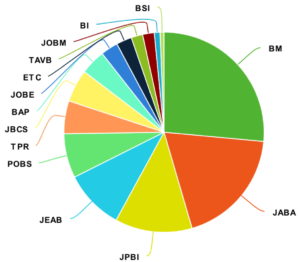In a companion post I highlighted the 21st century behavior analysis articles that have had the most dissemination impact, as defined by the Altmetric Attention Score. Now let’s look at the articles that had the most scholarly impact, as defined in terms of citations.
On December 15, 2023, I used the Altmetric Explorer app to examine the Dimensions Citations count for all articles published since 2000 in a variety of behavior analysis journals.
[Please note that there are several different tools for tracking citations, and they all work somewhat differently. Results from the various tools are positively correlated, with Dimensions counts among the most conservative, and Google Scholar counts the most liberal. All of the tools detect citations that the others don’t, so the only appropriate use of these tools is to compare relative citation counts for different articles as depicted by the same tool. That’s what I did here, and somewhat different results might be obtained using a different tool.]
The Top 30 articles are listed in the table at the end of this post. For dissemination impact, unsurprisingly, most of the top-performing articles focused on application, but scanning the citation table reveals a hefty handful of articles with a more basic, theoretical, or methodological focus.
A cut-off of 95 citations yielded a list of the 305 most-cited papers in 21st Century behavior analysis. I selected this cut-off because it appears that, across several disciplines, less than 1% of articles achieve a citation count of around that high.

This pie chart shows the proportion of most-cited articles that came from each of 14 journals (for several other journals, none of their articles made the list). The citation top dog journal is Behavior Modification, followed by Journal of Applied Behavior Analysis (JABA), Journal of Positive Behavior Interventions, and Journal of the Experimental Analysis of Behavior (JEAB).
Full disclosure: You could quibble with these data in lots of ways. Some journals (like JABA) publish tons of articles every year, and so presumably have better odds of generating a citation overperformer, compared to, say, The Analysis of Verbal Behavior, which has averaged only about 5 articles per year since 2000. One of the journals (Journal of Contextual Behavioral Science) didn’t start publishing till 2006, and may have been disadvantaged in this way. The large majority of behavior analysis journals are applied, so more-basic journals (like JEAB) may be at a disadvantage when it comes to citation opportunities. Journals with a general topical focus have a bigger potential audience than journals that specialize in a niche topic. And so on.
Nevertheless, it remains objectively true that some journals produced more highly-cited articles than others, and that is one fairly standard measure of journal productivity.
You’ll notice in the table below that most of the Top 30 articles are from the early 2000s. This is expected given that citations usually take a lot of years to build up. Repeat this analysis in 10 or 15 years, and some articles from the 2010s might look more impactful than they do today.
You don’t have to spend much time with that Top 30 table to see that the topics that pulled the most citations don’t necessarily correspond to the topics that generate the most published articles in our discipline. Notably, autism is a minority topic in that table.
Which raises a final point. If I were just starting my career, I’d want to take a careful look at the kinds of papers that have gotten a lot of scholarly attention in recent years. While it’s important, of course, to study that interest you, there are distinct benefits to studying things that other people are interested in. This is a do-as-I-say-not-as-I-do issue. Once made a list of my favorite published articles I’ve been involved with, and discovered that almost without exception they were among my least cited papers!
If you want to build a research career, you need things that other people control: not just citations, but also grants, invitations to speak at conferences, appointments to editorial boards, and so on. If nobody’s reading your stuff, these goodies will be hard to obtain. Picking topics to study that others care about is a key step toward entering verbal communities that can sustain you for the rest of your career. It’s worth choosing strategically.
The Top 30 Most-Cited Behavior Analysis Articles of the 21st Century (So Far)
According to Dimensions Citations; data from Altmetric.com via the Altmetric Explorer app.
Key to Journal Name Abbreviations
BAP = Behavior Analysis in Practice
BI = Behavioral Interventions
BM = Behavior Modification
BSI = Behavior and Social Issues
ETC = Education and Treatment of Children
JABA = journal of Applied Behavior Analysis
JCBS = Journal of Contextual Behavioral Science
JEAB = Journal of the Experimental Analysis of Behavior
JOBE = Journal of Behavioral Education
JOBM = Journal of Organizational Behavior Management
JPBI = Journal of Positive Behavioral Interventions
POBS = Perspectives on Behavior Science
TAVB = The Analysis of Verbal Behavior
TPR = The Psychological Record
